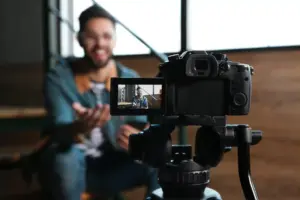Why Product Photography Tips Matter for Ecommerce Images
Shoppers make split-second decisions based on visuals. Independent UX research has shown that product images are among the top drivers of purchase confidence, ranked alongside price and shipping details. In practice, better ecommerce images reduce returns, speed up decisions, and increase average order value.
According to shopper behavior studies, users rely on clear, detailed images to assess quality and fit. When brands add consistent lighting, multiple angles, and contextual shots, they reduce uncertainty—one of the biggest barriers to conversion. If you’re serious about scaling your store, investing in a systematic approach to your photography isn’t optional—it’s a competitive advantage.
For a deeper evidence base on product image UX patterns, see this high-authority overview from the Baymard Institute.
Gear That Delivers: Practical Product Photography Tips on Equipment
You don’t need a Hollywood budget to create stunning ecommerce images. You do need reliable, consistent tools.
- Camera: A modern smartphone or entry-level mirrorless camera with manual controls works well. Prioritize sharpness and dynamic range over brand hype.
- Lenses: A 50mm (full-frame) or 35mm (APS-C) prime lens reduces distortion for product shots. For small items, consider a macro lens.
- Lighting: Two continuous LED panels with adjustable color temperature and a softbox or diffusion panel will handle 80% of scenarios.
- Stabilization: A sturdy tripod with a ball head keeps shots consistent—critical for batch shooting and composite edits.
- Backdrop: Seamless white paper, acrylic, or foam board for clean backgrounds; textured boards for lifestyle shots.
- Reflectors and Flags: White foam board (bounce), black foam board (cut light/spill), and a silver reflector for specular highlights.
Pro tip: Invest first in light and stability. A modest camera with great light will outperform an expensive camera with poor light.
Lighting 101: Simple, Repeatable Setups for Ecommerce Images
Lighting is where many product photography tips converge. Your goal is to create a soft, even key light with controlled shadows that emphasize shape without distracting harshness.
Two-Light Setup (Most Products)
- Place your key light at a 45° angle to the product, slightly above eye level, diffused through a softbox.
- Use a fill light at 30–50% power on the opposite side to soften shadows (or use a white reflector for a natural look).
- Flag off light spill with black foam board to keep edges crisp and control reflections.
Window Light Setup (Budget-Friendly)
- Set the product near a large window with indirect light.
- Use a sheer curtain or diffusion fabric to soften glare.
- Add a white reflector opposite the window to fill shadows.
Glossy products: Move lights farther away and use larger diffusion to minimize harsh specular highlights. A polarizing filter can help control reflections on glass or metal.
Composition and Styling: Product Photography Tips for Visual Clarity
Your composition should communicate function, scale, and quality at a glance. The most effective ecommerce images follow a style guide and repeatable framing rules.
- Hero shot: One centered image on a clean background (often white) showing the product’s true color and shape.
- Angles: Front, back, left/right, 45°, top-down. Include close-ups of textures, ports, fasteners, or key features.
- Scale indicators: Show the product next to a familiar object or in-hand.
- Lifestyle context: Photograph in use to demonstrate size and benefits. Keep props minimal and on-brand.
- Consistency: Match horizon lines, crop ratios, shadows, and negative space across SKUs for a cohesive grid.
Quick win: Establish a crop ratio (e.g., 1:1 or 4:5) and a “virtual horizon” height that you replicate on every shoot. This makes category pages look polished and trustworthy.
Backgrounds and Surfaces That Elevate Ecommerce Images
Backgrounds should enhance, not compete with, your product. For marketplaces and catalogs, stick to pure white (#FFFFFF) or near-white. For branded stores, use subtle textures or colors that align with your palette.
- Clean white: Best for search and marketplaces; easy to clip and composite.
- Textured surfaces: Concrete, wood, linen, or stone add warmth for lifestyle shots.
- Color backdrops: Use brand colors in soft tones to avoid color cast; test for hue shifts on reflective items.
- Acrylic risers and stands: Elevate small products, create shadow separation, and add a premium feel.
Maintain a library of reusable surfaces and props. Label them by collection or season to speed up future shoots and maintain consistency.
Editing Workflow: Non-Destructive Product Photography Tips
A streamlined editing process ensures your ecommerce images look consistent across campaigns. Build a preset and profile system so multiple shooters can match the same look.
- Ingest and cull: Rate and reject quickly. Keep a shortlist for batch edits.
- Color accuracy: Use a gray card in your first frame; set white balance from it across the set.
- Global adjustments: Exposure, contrast, highlights/shadows, presence. Apply your base preset.
- Local corrections: Remove dust, scratches, or sensor spots; even out reflections.
- Background clean-up: For white backgrounds, aim for consistent RGB values; refine edges for hairlines or transparent materials.
- Output profiles: Export variations for web (sRGB), marketplace specs, and print as needed.
Pro tip: Create a “Do/Don’t” style guide with reference images—how to handle shadows, reflection intensity, retouching limits, and skin tones for apparel.
Optimization for Speed: Making Ecommerce Images Load Fast
Slow pages kill conversions. The best product photography tips include technical optimization so images look crisp without bogging down your site.
- Format: Use WebP or AVIF for web; JPG for marketplace compatibility; PNG only for transparency-heavy graphics.
- Right-size: Export at the maximum display size (e.g., 1600–2000 px on the long edge) plus 2x variants for high-density screens.
- Compression: Use 70–85 quality for JPG; test visually to avoid banding.
- Lazy loading: Defer below-the-fold images and prefetch priority hero images.
- Responsive images: Implement srcset and sizes attributes to serve the right file per viewport.
- SEO: Descriptive file names, alt text with keywords and attributes (material, color), and structured data for product pages.
Bonus: Add width and height attributes to minimize layout shift (CLS) and improve Core Web Vitals.
Conversion-Focused Product Photography Tips You Can Test
Move beyond “pretty” to “profitable.” Use A/B testing and analytics to validate which ecommerce images convert best.
- Angle testing: Try straight-on vs. 45° hero angles.
- Context: Compare pure white background vs. simple lifestyle backdrop for key SKUs.
- Human element: For wearables or carry items, test in-hand or on-model shots to convey scale.
- Detail emphasis: Close-ups of textures, seams, or USP features often increase perceived quality.
- Interactive media: 360° spins or short product videos can lift conversions for complex items.
Case example: An accessories brand tested white-background vs. soft-lifestyle hero images on their top 10 SKUs. Lifestyle heroes improved add-to-cart rate by 12% on fashion items but underperformed for electronics, where customers preferred clinical clarity. The takeaway: segment your approach by product category.
Building a Scalable System: From Shot List to File Naming
High-performing ecommerce images come from process, not luck. Document your workflow so any photographer or contractor can replicate results.
Pre-Production
- Shot list: SKU, required angles, close-ups, and lifestyle concepts.
- Style guide: Backgrounds, color palette, shadows, and retouching standards.
- Props and wardrobe: Keep an updated inventory by season and category.
Production
- Lighting map: Diagram distances, angles, and power settings.
- Color reference: First frame with a color checker for accurate calibration.
- Tethered capture: Review sharpness and exposure on a calibrated display.
Post-Production
- File naming: brand_sku_color_angle_variant.jpg (e.g., acme_1234_black_45_hero.jpg).
- Version control: Keep RAW, master TIFF/PSD, and web exports in separate folders.
- Approval workflow: Internal review, QA checklist, then publish.
Tip: Create templates for your shot list, lighting map, and QA checklist. This reduces errors during large seasonal launches.
Apparel and Reflective Items: Specialized Product Photography Tips
Some categories require extra finesse to produce professional ecommerce images.
- Apparel: Use consistent mannequin or on-model poses; steam garments; align seams and hems; use pins/clips on the back to avoid wrinkles.
- Jewelry: Use larger diffusion, a light tent, and a macro lens; a polarizer can reduce glare; consider focus stacking for depth.
- Bottles and glass: Backlight the subject to define edges; keep labels perfectly aligned; minimize fingerprints with cotton gloves.
- Metallic surfaces: Increase diffusion size; use flags to shape reflections rather than trying to remove them entirely.
For all reflective items, think of reflections as content. Shape them to outline form and communicate quality.
Accessibility and SEO for Ecommerce Images
Accessibility isn’t just a compliance box—it strengthens both user experience and organic visibility.
Screen readers and search engines both rely on descriptive, structured metadata.
Best practices for accessible & SEO-friendly ecommerce images:
- Alt text: Write helpful, keyword-rich descriptions. Example: “Men’s leather wallet in chestnut brown, bi-fold with coin pocket, open view.”
- Structured data: Add Product schema with image markup for richer SERP results.
- Captions: Use sparingly to highlight product context or use cases.
- File names: Use consistent, descriptive naming: brand_product-color_view.jpg.
- Testing: Run accessibility checks (WAVE, Axe) to ensure compliance across devices.
Done right, accessibility isn’t just about meeting standards—it ensures every visitor, regardless of ability, gets a clear understanding of your product.
Key Takeaways: Product Photography Tips That Sell
- Invest in lighting and stability first—your camera is secondary.
- Build a repeatable style guide for consistent ecommerce images across SKUs.
- Optimize for speed and SEO—fast-loading, keyword-optimized images lift rankings and conversions.
- Use A/B testing to validate what works for your audience.
- Scale with process documentation so every shoot is repeatable and efficient.
Great ecommerce photography isn’t about artistic flair alone—it’s about clarity, speed, and persuasion that turn browsers into buyers.



